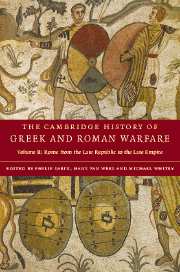Book contents
- Frontmatter
- Part I The Late Republic and the Principate
- Part II The later Roman Empire
- 7 International relations
- 8 Military forces
- 9 War
- 10 Battle
- 11 Warfare and the state
- 12 War and Society
- Chronological table
- Glossary
- List of ancient authors
- Bibliography
- Index of ancient passages cited
- General index
- Map 6. The provinces under Trajan."
- References
10 - Battle
from Part II - The later Roman Empire
Published online by Cambridge University Press: 28 March 2008
- Frontmatter
- Part I The Late Republic and the Principate
- Part II The later Roman Empire
- 7 International relations
- 8 Military forces
- 9 War
- 10 Battle
- 11 Warfare and the state
- 12 War and Society
- Chronological table
- Glossary
- List of ancient authors
- Bibliography
- Index of ancient passages cited
- General index
- Map 6. The provinces under Trajan."
- References
Summary
The army that the emperor Heraclius led to victory against the Persians in the 620s undoubtedly differed in composition and appearance from the army with which Constantine restored imperial unity in the 320s, but perceptions of the nature and pace of change over these three centuries must be balanced by an awareness of fundamental continuities in the combat operations of the Roman army. This period has long been characterized rather simplistically as the dawning of a new age of ‘medieval’ warfare, when armoured horsemen came to dominate the battlefields of Europe and the Near East. The Gothic victory at Adrianople in 378 traditionally heads the chronology of this development, but has itself been the subject of considerable reinterpretation. Recent studies have stressed the very gradual nature of this transformation, which was one of changing roles and emphases rather than revolutionary innovation, and which was only profound towards the very close of this era. As with the army of the Principate, however, scholarship has generally concentrated on aspects of the late Roman army other than its performance in combat, the supreme test of any military organization’s effectiveness and arguably its primary function. Emotive perceptions of ‘decline and fall’ continue therefore to mould modern assessments, and inefficiency, indiscipline and low morale are charges regularly levelled against late Roman soldiers, often in the context of their perceived ethnic heterogeneity and ‘barbarization’. The persistent application of the term ‘Byzantine’ to eastern Roman armies in the fifth and sixth centuries is also unhelpful, by separating the military and political fate of the western Empire and creating a false impression of discontinuity in late antique military practices.
- Type
- Chapter
- Information
- The Cambridge History of Greek and Roman Warfare , pp. 342 - 378Publisher: Cambridge University PressPrint publication year: 2007
References
- 13
- Cited by

